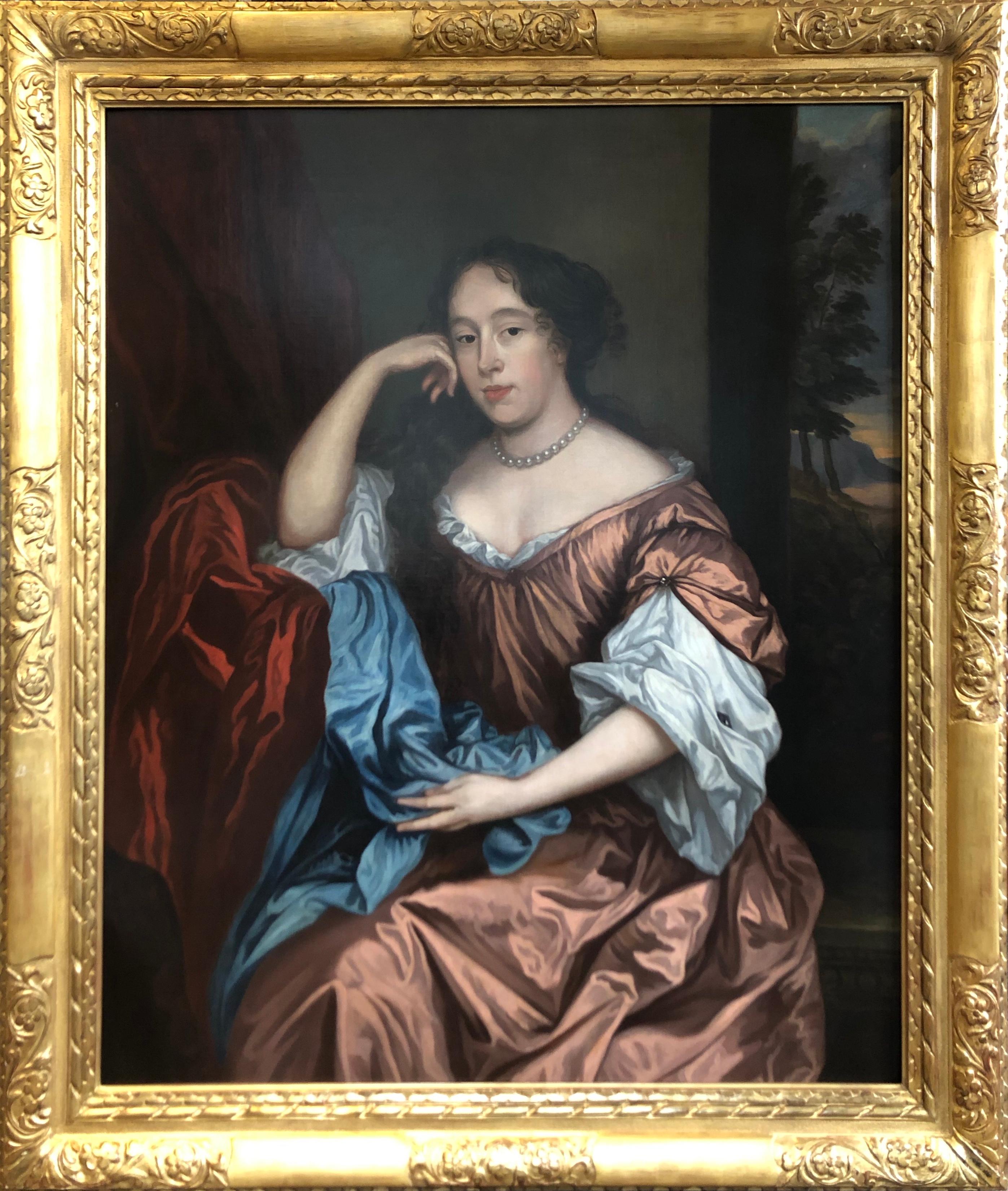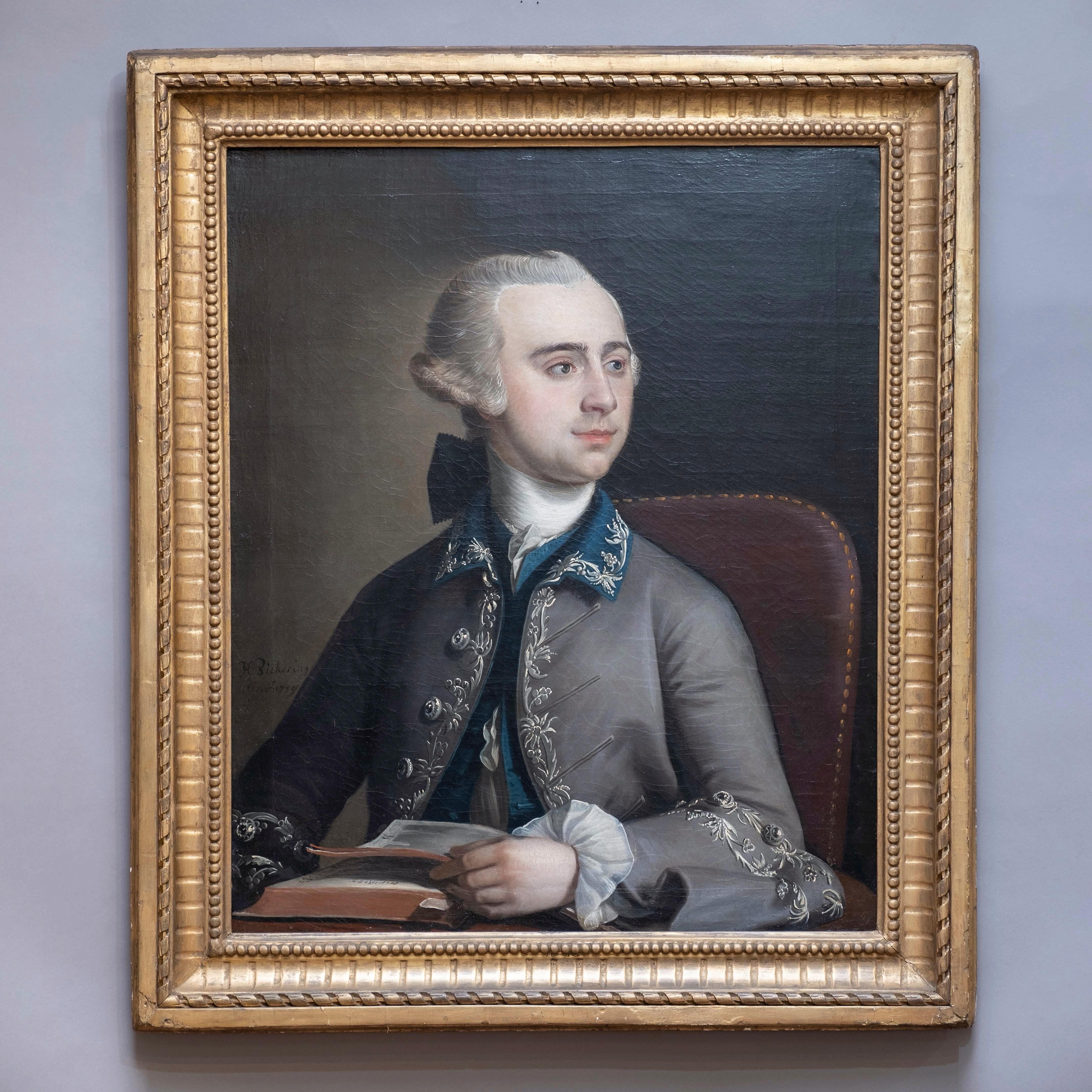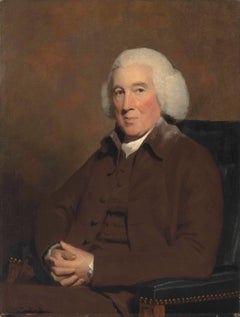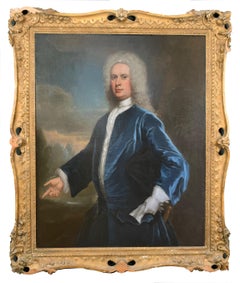
Oil Painting Portrait of the oboist John Parke (1745–1829)
View Similar Items
Want more images or videos?
Request additional images or videos from the seller
1 of 11
Thomas HickeyOil Painting Portrait of the oboist John Parke (1745–1829)c.1790
c.1790
About the Item
- Creator:Thomas Hickey (1741-1824, Irish)
- Creation Year:c.1790
- Dimensions:Height: 57 in (144.78 cm)Width: 46 in (116.84 cm)
- Medium:
- Movement & Style:
- Period:
- Condition:
- Gallery Location:London, GB
- Reference Number:1stDibs: LU67334123872
About the Seller
5.0
Vetted Seller
These experienced sellers undergo a comprehensive evaluation by our team of in-house experts.
Established in 1990
1stDibs seller since 2017
40 sales on 1stDibs
More From This SellerView All
- 18th Century Oil Painting Portrait of Provost John Pitcairn of DundeeBy Sir Henry RaeburnLocated in London, GBThe pendant to the present portrait showing John Pitcairn's wife Jean, née Robertson, is in the Huntington Art Gallery, San Marino. Both works are datable to the 1790s. Pitcairn, who served as Provost of Dundee from 1782-84, a position his father-in-law also held from 1731-32, later sat to Raeburn for another portrait, dated to circa 1820, which is now in the Royal Scottish Academy, Edinburgh Sale of Christie's London: Wednesday, July 9, 2014 [Lot 00212] Old Master & British Paintings Day Sale Sold For 22,500 GBP Premium Provenance By descent from the sitter to his great-grandson, Ronald Andrew Pitcairn of Pitcullo; Christie's, London, 25 June 1904, lot 58 (200 gns. to Wallis). Alexander Reid, Glasgow. With Agnew's, London, where acquired by A.R. Wilson Wood, 7 April 1909; Christie's, London, 26 June 1914, lot 78 (850 gns. to Agnew). Anonymous sale; Christie's, London, 24 November 1972, lot 27 (320 gns.) Private collection, Dublin, Ireland Exhibition Edinburgh, Royal Scottish Academy, 1876, no. 256 Literature W. Armstrong, Sir Henry Raeburn, London, 1901, p. 110. J. Greig, Sir Henry Raeburn, R.A., His life and work with a catalogue of his pictures, London, 1911, p. 55. R. Asleson and S.M. Bennett, British Paintings at The Huntington, New Haven and London, 2001, p. 312, fig. 12 Sir Henry Raeburn FRSE RA RSA (4 March 1756 – 8 July 1823) was a Scottish portrait painter and Scotland's first significant portrait painter since the Union to remain based in Scotland. He served as Portrait Painter to King George IV in Scotland. Raeburn was born the son of a manufacturer in Stockbridge, on the Water of Leith: a former village now within the city of Edinburgh. He had an older brother, born in 1744, called William Raeburn. His ancestors were believed to have been soldiers, and may have taken the name "Raeburn" from a hill farm in Annandale, held by Sir Walter Scott's family. Orphaned, he was supported by William and placed in Heriot's Hospital, where he received an education. At the age of fifteen he was apprenticed to the goldsmith James Gilliland of Edinburgh, and various pieces of jewellery, mourning rings and the like, adorned with minute drawings on ivory by his hand, still exist. Soon he took to the production of carefully finished portrait miniatures; meeting with success and patronage, he extended his practice to oil painting, at which he was self-taught. Gilliland watched the progress of his pupil with interest, and introduced him to David Martin, who had been the favourite assistant of Allan Ramsay the Latter, and was now the leading portrait painter in Edinburgh. Raeburn was especially aided by the loan of portraits to copy. Soon he had gained sufficient skill to make him decide to devote himself exclusively to painting. George Chalmers (1776; Dunfermline Town Hall) is his earliest known portrait. In his early twenties, Raeburn was asked to paint the portrait of a young lady he had noticed when he was sketching from nature in the fields. Ann was the daughter of Peter Edgar of Bridgelands, and widow of Count James Leslie of Deanhaugh. Fascinated by the handsome and intellectual young artist, she became his wife within a month, bringing him an ample fortune. The acquisition of wealth did not affect his enthusiasm or his industry, but spurred him on to acquire a thorough knowledge of his craft. It was usual for artists to visit Italy, and Raeburn set off with his wife. In London he was kindly received by Sir Joshua Reynolds, the president of the Royal Academy, who advised him on what to study in Rome, especially recommending the works of Michelangelo, and gave Raeburn letters of introduction for Italy. In Rome he met his fellow Scot Gavin Hamilton, Pompeo Girolamo Batoni and Byers, an antique dealer whose advice proved particularly useful, especially the recommendation that "he should never copy an object from memory, but, from the principal figure to the minutest accessory, have it placed before him." After two years of study in Italy he returned to Edinburgh in 1787, and began a successful career as a portrait painter. In that year he executed a seated portrait of the second Lord President Dundas. Examples of his earlier portraiture include a bust of Mrs Johnstone of Baldovie and a three-quarter-length of Dr James Hutton...Category
18th Century Old Masters Figurative Paintings
MaterialsOil
- 17th Century Oil Painting Portrait of a Young English BoyBy Gerard SoestLocated in London, GBGerard SOEST (1600 - 1681) Portrait of a Young Boy oil on canvas 35.5 x 30.5 inches inc. frame Gerard Soest (circa 1600 – 11 February 1681), also known as Gerald Soest, was a portra...Category
17th Century Old Masters Portrait Paintings
MaterialsOil
- 18th Century Oil Painting Portrait of Phillip, 6th Viscount Wenman.By Nathaniel Dance-HollandLocated in London, GBSir Nathaniel Dance-Holland (1750-1811) was an English portrait painter and one of the founding members of the Royal Academy in 1768. Justly celebrated in his lifetime he won several...Category
Late 18th Century Old Masters Portrait Paintings
MaterialsOil
- Stunning 17th Century Oil Painting - Study of a Head of a ManBy Anthony van DyckLocated in London, GBStudio of Sir Anthony Van Dyck (1599-1641, Flemish) Study of a Head of Man Circa 1627-32, Van Dyck’s second Antwerp period Oil on paper, laid down on canvas Dimensions 15 x 14 inches...Category
17th Century Old Masters Portrait Paintings
MaterialsOil
- Lady Dormore - A 16th Century Portrait of a key member of Shakespeare's EnglandLocated in London, GBLady Dormer, Mary Browne c. 1592 oil on panel 35 x 29 inches, unframed; 41 x 34.75 inches, inc. frame Inscribed 'Lady Dormore' Mary married Henry Wriothesley, 2nd Earl of Southampton who gave birth to Henry Wriothesley, 3rd Earl of Southampton - one of the great figures in Shakespears"s circle and founder of the Virginia company, developers of Virginia USA. Henry Wriothesley, born 6 October 1573 at Cowdray House, Sussex, was the only son of Henry Wriothesley, 2nd Earl of Southampton, by Mary Browne, the only daughter of Anthony Browne, 1st Viscount Montague, and his first wife, Jane Radcliffe.[5] He had two sisters, Jane, who died before 1573, and Mary (c. 1567 – 1607), who in June 1585 married Thomas Arundell, 1st Baron Arundell of Wardour.[6] After his father's death, Southampton's mother married firstly, on 2 May 1595, as his second wife, Sir Thomas Heneage (d. 17 October 1595), Vice-Chamberlain of the Household, and secondly, between 5 November 1598 and 31 January 1599, Sir William Hervey. She died in November 1607.[7] Early life When his father died on 4 October 1581 Southampton inherited the earldom and landed income valued at £1097 6s per annum. His wardship and marriage were sold by the Queen to her kinsman, Charles, Lord Howard of Effingham, for £1000. According to Akrigg, Howard then "entered into some further agreement, of which no documentation can now be found, which transferred to Lord Burghley personally the custody and marriage of the young Earl, but left Howard holding his lands", and late in 1581 or early in 1582 Southampton, then eight years of age, came to live at Cecil House in the Strand.[8] In October 1585, at age twelve, Southampton entered St John's College, Cambridge,[9] graduating M.A. on 6 June 1589.[10] His name was entered at the Gray's Inn legal society before he left the university, and he was admitted on 29 February 1588.[11] On Southampton's 16th birthday, 6 October 1589, Lord Burghley noted Southampton's age in his diary, and by 1590 Burghley was negotiating with Southampton's grandfather, Anthony Browne, 1st Viscount Montague, and Southampton's mother, Mary, for a marriage between Southampton and Lord Burghley's eldest granddaughter, Elizabeth Vere, daughter of Burghley's daughter, Anne Cecil, and Edward de Vere...Category
16th Century Old Masters Figurative Paintings
MaterialsOil
- C19th Portrait Princesse de Joinville of Brazil - Spectacular fit for a palaceBy Henri d'Ainecy MontpezatLocated in London, GBPortrait of Princess de Joinville riding a Bay Horse Henri d’Aincy, Le Comte Monpezat (French 1817-1859) Painted circa 1837-9 oil on canvas 113 x 92 inches (including frame) 92 x 70 inches (unframed) Provenance – from a private royal collection This magnificent portrait depicts Princess de Joinville, the daughter of Pedro I, Emperor of Brazil and the King of Portugal. Through her illustrious family she was directly related Alexander III and Nicholas II of Russia and the Russian royal family, as well as to many of the great ruling families of Europe. The work clearly confirms Monpezat as one of the most accomplished equestrian portrait painters in France in the early nineteenth century. In terms of scale, quality and dramatic power, it must surely be considered amongst his finest works. The stance of the powerful thoroughbred - in half rear - emphasises the calm nature and courage of the Princess. Francisca of Brazil (1824-98) married a son of Louis Philippe I, the King of the French, and had three children. Born at the Imperial Palace of Saint Christopher, her youngest brother was the future Pedro II...Category
1830s Old Masters Portrait Paintings
MaterialsOil
You May Also Like
- Oil on Canvas Painting Portrait of the Italian Noble Family of Zanardi CountBy Lucia Casalini TorelliLocated in Firenze, ITThis museum quality old master oil on canvas formal portrait painting depicting the family of the Count Zanardi is signed by the artist- the female painter Lucia Casalini Torelli- and published in a book dedicated to Casalini Torelli’s workshop and academy. This palatial masterpiece artwork comes directly from the ancient Villa Maraini Guerrieri - Palidano di Gonzaga (Mantua), an historic Italian heritage building owned by the descendants of the family portrayed for more than two centuries, until 1998. The big scale of this oil on canvas masterpiece painting states the relevance of Lucia Casalini Torelli as a painter. The present artwork is a formal family portrait painting that aim to introduce the characters depicted according to their social role in the society. The noble family is all gathered under a loggia overlooking a park, the landscape in the background is partially covered by a beautiful red cloth on the right side. The father stands up and holds the hand of his eldest son, proudly introducing his future heir. The son wears a light-blue dress and red boots, he is depicted in a serious pose holding a black tricorn hat under his arm and a rapier sword on his belt. The mother wears an elegant gold and dark green brocade dress, she is sitting with her youngest daughter on her knees while her second son is by her side. The little daughter wears a lovely long red and dress with white lace and holds an apple on her hand. The son stands next to his mother and is dressed in a brown priestly clothes. This palatial old masters piece was probably painted in 1740 due to the similarities with Cardinal Doria’ s portrait, now on display at the Doria Palace Museum, the official residence of the Prince of Genoa. The painting features original canvas (“prima tela”) and antique original patina, it is in excellent overall condition considering the age, use and its large scale. A formal detailed condition report and the results of the inspection with the UV lamp accompanied by photos is available on request. As well as for its exceptional quality and quite perfect state of conservation, this painting is particularly important and even more valuable both for the artist who painted it and for its absolutely exclusive provenance. Lucia painted the most prominent and powerful noble families of her time, the location of these paintings is unknown to the art market as it is extremely likely that the portraits are still kept in private collections. Furthermore, Lucia was one of the most appreciated artists of her time, so important that she was admitted as a member of the academy at a time when women were forbidden to attend these studies. In 1706, Felice Torelli...Category
18th Century Old Masters Portrait Paintings
MaterialsCanvas, Oil
- Portrait of a Lady, After Sir Peter Lely (1610-1680) Oil PaintingBy After Sir Peter LelyLocated in Uppingham, GBOil Painting After Sir Peter Lely (1610-1680) Portrait of a Lady Housed in a Lely gold Leaf Frame. Peter Lely: In 1647 he became a member of the Pain...Category
17th Century Old Masters Portrait Paintings
MaterialsOil
- Oil Painting Portrait, attributed to John Vanderbank (1694-1739)By John VanderbankLocated in Uppingham, GBOil Painting Portrait of John Campbell, 4th Duke of Argyll,, att to John Vanderbank (1694-1739) Housed in a swept frame which has been restored after photo. Canvas Size 50" x 40", Fr...Category
1690s Old Masters Portrait Paintings
MaterialsCanvas, Oil
- 18th century portrait of the painter Nathaniel DanceLocated in London, GBCollections: Robert Gallon (1845-1925); Private Collection, UK. Oil on canvas laid down on panel Framed dimensions: 11.5 x 10 inches This highly engaging, previously unpublished portrait by Johan...Category
18th Century Old Masters Portrait Paintings
MaterialsCanvas, Oil, Wood Panel
- 19th century portrait painted in St Petersburg in 1819Located in London, GBSigned, inscribed and dated, lower right: 'Geo Dawe RA St Petersburgh 1819', also signed with initials, lower centre: 'G D RA'; and signed and inscribed verso: 'Geo Dawe RA Pinxit 1819 St Petersburgh'; Also inscribed on the stretcher by Cornelius Varley with varnishing instructions. Collections: Private collection, UK, 2010 Literature: Galina Andreeva Geniuses of War, Weal and Beauty: George Dawe...Category
19th Century Old Masters Portrait Paintings
MaterialsCanvas, Oil
- Attributed to Cornelius de Neve, Portrait of John, Lord BelasyseLocated in London, GBAttributed to Cornelius de Neve (circa 1612-1678) Portrait of John, Lord Belasyse (1614-1689) Oil on canvas; held in a period style carved polished wood frame. Dimensions refer to framed size. Cornelius de Neve, was born in Antwerp, possibly training under the Dutchman Mierveldt and settling in London by 1627. It has been suggested he possibly associated with Van Dyck, though his works show a strong debt to painting in England prior to his arrival, particularly John de Critz...Category
Mid-17th Century Old Masters Portrait Paintings
MaterialsOil
Recently Viewed
View AllMore Ways To Browse
Thomas Oil Painting Ships
18th Century Portrait Spain
18th Century Spanish Portrait
Bath Oil Painting Masters
A Drury
18th Irish Painting
18th Century Irish Painting
18th Century French Gardens Art
18th C Spanish Painting
Irish Oil Painting 18th
Avon Antique
Antique Stratford
Portugal Old Master
Queen Concert
Vauxhall Antique
Antique Music Player
Antique Music Players
Stratford On Avon















